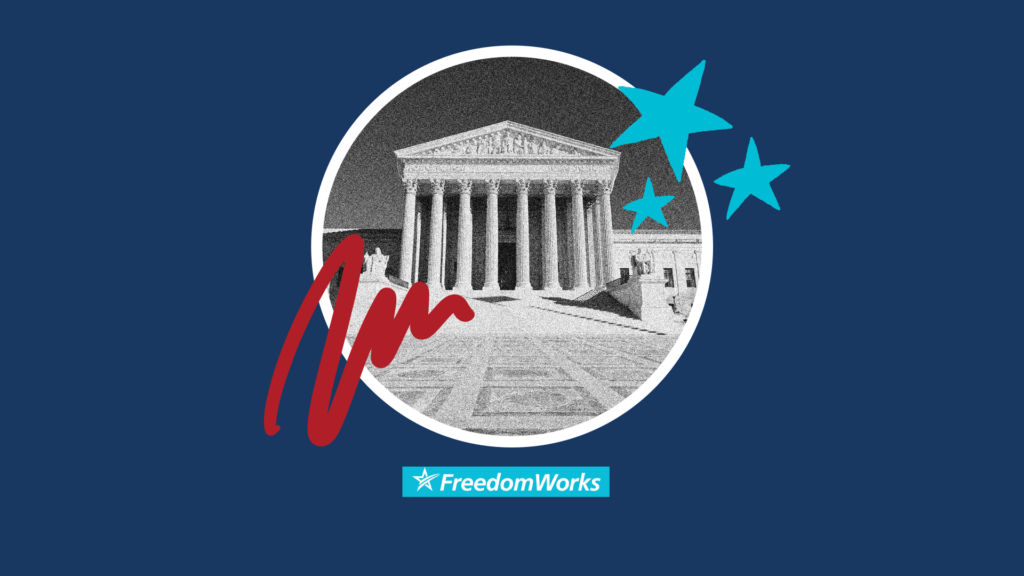Kelo v. New London: How the Supreme Court Gutted Constitutional Protections for Private Property
Ten years ago today, the United States Supreme Court fundamentally changed the meaning and purpose of the Takings Clause of the Fifth Amendment, which allows for the use of eminent domain for “public use,” such as a road. But in a 5 to 4 decision, the Court ruled that eminent domain could be used to take property from a private citizen for purposes other than a public use.
At issue in Kelo v. City of New London was the city’s use of eminent domain to seize property for economic development. New London, a small Connecticut city located next to the Thames River, hoped to bring a Pfizer research center to the city and, with assistance from the state, offered the pharmaceutical giant a very generous tax abatement package worth some $78 million. Pfizer opened the $300 million facility in 2001.
Before the package was offered, the New London Development Corporation, a private entity working on behalf of the city, decided to use the opportunity to redevelop New London’s Fort Trumbull neighborhood to attract businesses and enhance the city’s tax base. The day before Thanksgiving in 2000, Susette Kelo was served with a condemnation notice of her little pink house. Other families’ homes were also condemned by the city.
Kelo unsuccessfully fought the theft of her property in state court, with the Connecticut Supreme Court ruling in favor of New London in March 2004. The Institute for Justice took Kelo’s case to the Supreme Court, arguing on her and other families behalf before justices in February 2005.
Just four months later, on June 23, 2005, the Supreme Court released its opinion in the case, deciding in favor of New London by redefining the Takings Clause of the Fifth Amendment to expand “public use” to include economic development purposes. Justice John Paul Stevens wrote the opinion for the majority, and he was joined by Court’s three other progressives. Justice Anthony Kennedy, the Court’s crucial swing vote, sided with the majority in a concurring opinion.
Justice Sandra Day O’Connor wrote a scathing dissent in the case, which was joined by Chief Justice William Rehnquist and Justice Antonin Scalia.
“Any property may now be taken for the benefit of another private party, but the fallout from this decision will not be random,” O’Connor wrote. “The beneficiaries are likely to be those citizens with disproportionate influence and power in the political process, including large corporations and development firms.”
“The Founders cannot have intended this perverse result,” she added.
In a separate but equally scathing dissent, Justice Clarence Thomas blasted the majority’s “perverse” opinion, writing that the “consequences of today’s decision are not difficult to predict, and promise to be harmful.”
“Allowing the government to take property solely for public purposes is bad enough, but extending the concept of public purpose to encompass any economically beneficial goal guarantees that these losses will fall disproportionately on poor communities,” Thomas explained. “Those communities are not only systematically less likely to put their lands to the highest and best social use, but are also the least politically powerful.”
The ramifications of Kelo were almost immediately felt. In the June 2006 report, Opening the Floodgates: Eminent Domain Abuse in the Post-Kelo World, the Institute for Justice noted that “[s]ince the decision was handed down, local governments threatened eminent domain or condemned at least 5,783 homes, businesses, churches, and other properties so that they could be transferred to another private party.” Prior to Kelo, between 1998 and 2002, there were just under 10,300 threats of Kelo-style condemnations or actual takings of private property for private use.
In 1792, James Madison, the Father of the Constitution and author of the Bill of Rights, explained that private property has a sacred place in American society. “Government is instituted to protect property of every sort; as well that which lies in the various rights of individuals, as that which the term particularly expresses,” he wrote. “This being the end of government, that alone is a just government which impartially secures to every man whatever is his own.”
As Madison notes, one of the primary function of government is to protect an individual’s right to their property. So how is it possible that we got from this very protective view of property rights to the gutting of those protections in Kelo?
Unfortunately, the decline had been happening for decades. In 1954, the Supreme Court, in Berman v. Parker, upheld the District of Columbia Redevelopment Act, which called for the use of eminent domain for private purposes. The owners of a department store brought the suit against the District of Columbia, but their constitutional arguments fell on deaf ears.
Chief Justice William Douglas, in his opinion for the majority, relied heavily on judicial deference, a lazy legal theory that ostensibly serves as a rubber stamp for legislative power, to uphold the law.
“The concept of the public welfare is broad and inclusive. The values it represents are spiritual as well as physical, aesthetic as well as monetary. It is within the power of the legislature to determine that the community should be beautiful as well as healthy, spacious as well as clean, well balanced as well as carefully patrolled,” Douglas wrote. “In the present case, the Congress and its authorized agencies have made determinations that take into account a wide variety of values. It is not for us to reappraise them.”
The effect of that decision was profound. More than 5,000 people, the vast majority of whom were African-American, were displaced from their dwellings in the District of Columbia’s Southwest area.
As both O’Connor and Thomas noted in their dissents in Kelo, poor and minority communities are disproportionately impacted by eminent domain. The Institute for Justice detailed these problems in the June 2007 study, Victimizing the Vulnerable: The Demographics of Eminent Domain Abuse.
In addition to Berman v. Parker, Hawaii Housing Authority v. Midkiff was an ominous precursor to Kelo. In Midkiff, the Supreme Court upheld the constitutionality of Hawaii’s Land Reform Act of 1967, which authorized the use of eminent domain to redevelop distressed neighborhoods. In practice, however, the law was used by tenants to steal their landlord’s property.
Interestingly, Justice O’Connor wrote the opinion upholding the law for the unanimous court. Her arguments rested largely on judicial deference and the rational basis test, the most accommodating test that is used to determine whether government has exceeded its authority.
“This Court will not substitute its judgment for a legislature’s judgment as to what constitutes ‘public use’ unless the use is palpably without reasonable foundation,” O’Connor wrote. “Where the exercise of the eminent domain power is rationally related to a conceivable public purpose, a compensated taking is not prohibited by the Public Use Clause.”
Awkwardly, O’Connor’s opinion in Midkiff was cited by the majority in Kelo.
Kelo is uniquely interesting, however, because of what happened in its aftermath. In the months after the decision, most state legislatures began implementing crucial protections for private property owners through statutory law and/or constitutional amendments.
What happened in New London years after the Kelo decision was also profound. The city’s plans backfired. Kelo’s vacant lot, as of March 2014, sat empty for years after her home was relocated to another part of the city. In September 2011, it was reported that the lots where homes once stood in Fort Trumbull had become a place for local residents to leave tree branches and other debris.
In 2009, with its generous 10-year tax abatement set to end, Pfizer announced that it would leave New London, taking some 1,400 jobs from the city to a new location across the Thames River in nearby Groton, Connecticut, where Kelo now lives.
Congress has sought to address the Kelo decision through legislation. In May 2013, Rep. Jim Sensenbrenner (R-Wis.) introduced the Private Property Rights Protection Act. This bill, which has been introduced in every Congress since 2005, would have protected Americans from Kelo-style takings.
The Private Property Rights Protection Act passed the House of Representatives by a vote of 353 to 65. Unfortunately, the Senate, then controlled by Democrats, never took it up. The bill has not yet been reintroduced in the current Congress.
With Republicans now in control of both chambers of Congress, the Private Property Rights Protection Act, or a similar bill, should be a priority for party leaders. As demonstrated by last year’s vote, ending abuse of eminent domain has broad bipartisan support, and polls have revealed strong public backing.
Property rights are, as constitutional scholar Timothy Sandefur has said, the cornerstone of liberty. Property is one of our most basic economic freedoms and a valuable means to prosperity. Restoring the promise of individual liberties protected by the Fifth Amendment is the only way to undo the wrong done to Susette Kelo and her neighbors by the Supreme Court.




